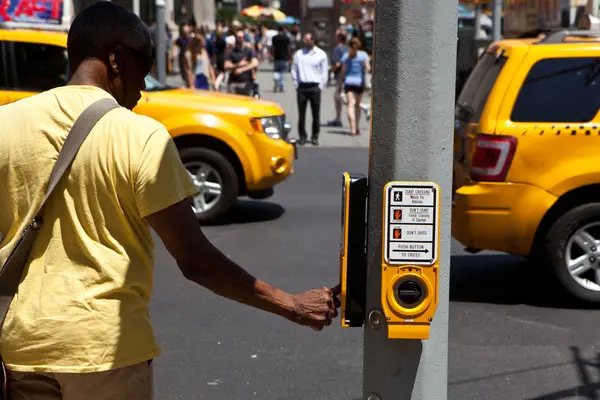Accessible Pedestrian Signals (APS) are devices that help people who are blind or have low vision cross streets safely by providing audio and other forms of tactile information. The APS devices fall under the Social Model of Disability, which focuses on creating an accessible world where everyone is included and can participate in society. While APS devices have been around since the 1970s, they were not fully incorporated in urban design until the 2000s. Americans with Disabilities Act played a critical role in pushing officials to start adopting APS devices as an inherent need in the development of urban infrastructure, rather than an ‘add-on’.

APS devices are installed on poles near crosswalks that has a steady beeping locator tone that allows people to locate it.
Audio Features
APS devices, created for individuals with low vision, feature locator tones to help users find them. The locator tones get louder or quieter depending on their surrounding. In busy, noisy areas like New York City, the tone becomes louder to stand out amidst the background noise. Conversely, in quieter towns and suburbs, the tone adjusts to be softer, minimizing disturbance for nearby residents. In Paris, the APS devices play a musical tone that many users find quite pleasant. (You can listen to it in the video linked in the references.)
Once users locate the APS and press the button with the raised arrow, they receive different signals depending on the device. Some APS units, particularly common in NYC, use a fast ticking sound to indicate it is safe to cross, which can be quite similar to the locator tone. Other devices provide a clearer indication by announcing “Walk sign is on” followed by an audible countdown, to determine the remaining time to cross the street safely. The audible countdown is much more accessible than the ticking sound which can be hard to distinguish amidst traffic or honking cars, however, it can be made more accessible by including other major languages other than english that allows POC/Hispanic/Asian population with disabilities to also feel safer while using crosswalks.
Tactile Features
To provide better utility, usability, and accessibility, an APS device is also designed with certain tactile features that allows people to depend on their sense of touch to navigate their way around if they cannot fully depend on their sense of hearing. The devices have a button with a raised arrow that points to the direction of the crosswalk related to the APS device. When the walk sign is on, the button starts vibrating indicating that the user can now cross the street. Since these devices are not fully standardised across the world, they can be found with unique accessible features in different place. For example, in London, APS devices have a cone on the bottom of the APS device, and when the walk sign is on, the cone starts turning.

Conclusion
The APS falls under the Social Model of Disability. While it is a great step towards creating an inclusive and more importantly a safe space, the APS device design need to be standardised and efforts should be made to continue improving the utility and usability of these devices.
